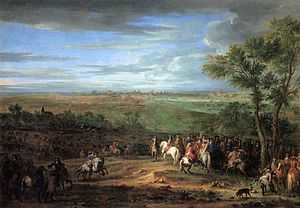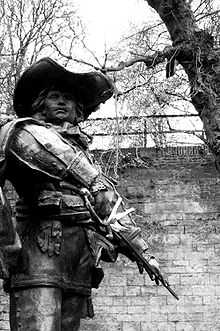Siege of Maastricht (1673)
| Siege of Maastricht | |||||||
|---|---|---|---|---|---|---|---|
| Part of the Franco-Dutch War | |||||||
 Louis XIV of France (on a white horse) in the camp in front of the besieged city of Maastricht. | |||||||
| |||||||
| Belligerents | |||||||
|
|
| ||||||
| Commanders and leaders | |||||||
|
|
| ||||||
| Strength | |||||||
|
24,000 infantry 16,000 cavalry 58 guns |
5,000 infantry 1,200 cavalry | ||||||
| Casualties and losses | |||||||
| Unknown | 6,000 dead, wounded, or captured | ||||||
The Siege of Maastricht(11 – 30 June 1673) ended when Jacques de Fariaux, the governor of the Dutch garrison, surrendered to an army under the command of Louis XIV during the Franco-Dutch War (1672–1678).
Prelude
The siege was one of the key elements in King Louis XIV's plans to attack the Netherlands, in order to revenge the humiliating conditions enforced on him by the Triple Alliance when he tried to fully conquer the Spanish Netherlands.
After making a feint for Ghent and Brussels, Louis marched his army past Maastricht, a condominium of the United Provinces and the Bishopric of Liège, in May 1672, not bothering to take the fortress. In 1673, when his supply lines became threatened he decided to capture Maastricht; the siege began on 11 June. The city would be the first major city to be attacked by Sebastien Vauban, the master of siegecraft in his time.
Siege

In addition to firing upon the city walls with cannon, Vauban ordered the building of trenches, in a zigzag pattern, parallel to the walls. These trenches made it more difficult for the defenders from having a clear shot at the attackers and, in addition, allowed for the protection of military miners to allow them to reach the base of the fortifications and plant mines to make a breach.
24 June was the feast day of Saint John the Baptist, and so Louis attempted to finish conquering the city in time to celebrate Mass in Maastricht's cathedral. The trenches were completed, and so the King's Regiment, and the Company of the Grey Musketeers led the march into the city, under the command of Captain-Lieutenant Charles de Batz-Castelmore d'Artagnan, also known as le compte (count) d'Artagnan. The French, after some difficult fighting, crossed the moat and seized a crescent-shaped fortification which would become the scene of the toughest fighting of the siege.
Most of the French were driven out by the Spanish auxiliaries soon afterwards, but about 30 men held out the entire night. The Duke of Monmouth (commander of the English forces fighting on the French side), accompanied by a young Captain John Churchill (the future Duke of Marlborough),[1] tried to take a covered road protecting the moat, and withdrew after suffering the loss of 300 men. The Dutch recaptured the crescent fortification soon afterwards, and when the Duke of Monmouth rallied his troops to a second assault, they were driven back once more, and Comte d'Artagnan was killed.
Finally, Louis ordered the artillery back into action, eliciting a surrender from the Dutch within a week (on 30 June 1673).
Aftermath
When the Treaty of Nijmegen ended the war between France and the Dutch, Maastricht was returned to the Dutch, though Louis kept a number of Habsburg cities. What is generally regarded as more significant about this battle were the revolutionary advances in siegecraft engineered by Vauban.
Notes
- ↑ Konstam 2011, p. 7.
References
- Davis, Paul K. (2001), Besieged: 100 Great Sieges from Jericho to Sarajevo, Oxford University Press
- Konstam, Angus (2011), Marlborough (illustrated ed.), Osprey Publishing, p. 7, ISBN 9781780962320